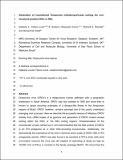Generation of recombinant Oropouche viruses lacking the nonstructural protein NSm or NSs
Abstract
Oropouche virus (OROV) is a midge-borne human pathogen with a geographic distribution in South America. OROV was first isolated in 1955, and since then, it has been known to cause recurring outbreaks of a dengue-like illness in the Amazonian regions of Brazil. OROV, however, remains one of the most poorly understood emerging viral zoonoses. Here we describe the successful recovery of infectious OROV entirely from cDNA copies of its genome and generation of OROV mutant viruses lacking either the NSm or the NSs coding region. Characterization of the recombinant viruses carried out in vitro demonstrated that the NSs protein of OROV is an interferon (IFN) antagonist as in other NSs-encoding bunyaviruses. Additionally, we demonstrate the importance of the nine C-terminal amino acids of OROV NSs in IFN antagonistic activity. OROV was also found to be sensitive to IFN-α when cells were pretreated; however, the virus was still capable of replicating at doses as high as 10,000 U/ml of IFN-α, in contrast to the family prototype BUNV. We found that OROV lacking the NSm protein displayed characteristics similar to those of the wild-type virus, suggesting that the NSm protein is dispensable for virus replication in the mammalian and mosquito cell lines that were tested. IMPORTANCE Oropouche virus (OROV) is a public health threat in Central and South America, where it causes periodic outbreaks of dengue-like illness. In Brazil, OROV is the second most frequent cause of arboviral febrile illness after dengue virus, and with the current rates of urban expansion, more cases of this emerging viral zoonosis could occur. To better understand the molecular biology of OROV, we have successfully rescued the virus along with mutants. We have established that the C terminus of the NSs protein is important in interferon antagonism and that the NSm protein is dispensable for virus replication in cell culture. The tools described in this paper are important in terms of understanding this important yet neglected human pathogen.
Citation
Tilston-Lunel , N L , Acrani , G O , Randall , R E & Elliott , R M 2016 , ' Generation of recombinant Oropouche viruses lacking the nonstructural protein NSm or NSs ' , Journal of Virology , vol. 90 , no. 5 , pp. 2616-2627 . https://doi.org/10.1128/JVI.02849-15
Publication
Journal of Virology
Status
Peer reviewed
ISSN
0022-538XType
Journal article
Description
Wellcome Trust provided funding to Richard M. Elliott under grant number 99220. Medical Research Council (MRC) provided funding to Natasha Louise Tilston-Lunel under grant number 1101085. FAPESP-São Paulo Research Foundation provided funding to Gustavo Olszanski Acrani under grant number 2013/02798-0.Collections
Items in the St Andrews Research Repository are protected by copyright, with all rights reserved, unless otherwise indicated.

